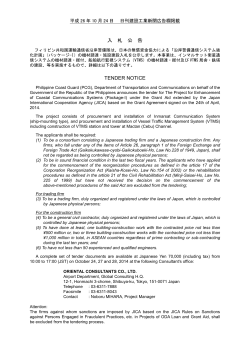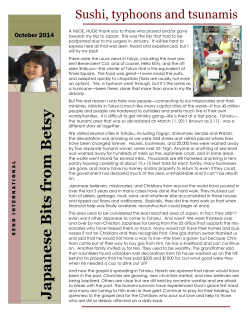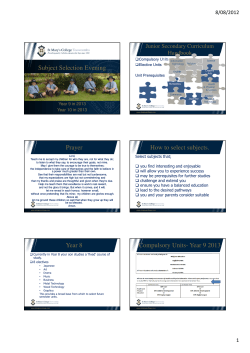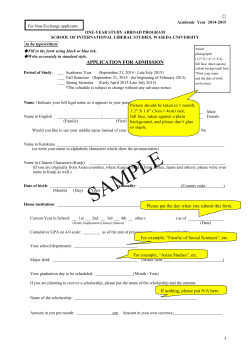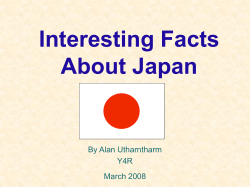
The Program of the 149 Meeting of the Linguistic Society of Japan th
The Program of the 149th Meeting of the Linguistic Society of Japan President: Director (LSJ) Director (Local) Shigeki KAJI Hirofumi AOKI Hideki TSUKAMOTO Dates: Saturday, November 15, Sunday 16, 2014 Venue: Ehime University, Johoku Campus 3, Bunkyo-cho, Matsuyama, Ehime Pref. 790-8577, Japan Schedule and program Day1 13:00 - 17:40 18:30 - 20:30 Day2 10:00 - 12:00 11:30 - 12:50 13:00 - 13:20 13:20 - 16:20 Oral presentations (The 3th &4th floor of Lecture Hall for General Education) Reception (Yamatoya-Honten) Workshops (The 2nd, 3th &4th floor of Lecture Hall for General Education) Poster presentations (The 3th floor of Lecture Hall for General Education) LSJ President’s address, etc. (Green Hall) Symposium (Green Hall) Symposium: Date: Sunday, November 16 (13:20 – 16:20) Place: Green Hall The Interface between Studies in Modern Languages and Historical Studies Organizer/Chair: Hideki TSUKAMOTO (Ehime University) Topics and Presenters: Theoretical Issues Surrounding Nominalization Particles Masayoshi SHIBATANI (Rice University) [S-1] The Accent of Numeral-Counter Combinations in Japanese Masayoshi KAKUDO (Professor Emeritus of Osaka University) [S-2] The Attributive Locative in Indo-Aryan Masato KOBAYASHI (University of Tokyo) [S-3] Analogy and Lexical Restructuring in Korean Noun Paradigms Chiyuki ITO (ILCAA, Tokyo University of Foreign Studies) [S-4] 1 ■Oral presentations (Saturday, November 16 13:00-17:40) Session A (Room 31) Chairs: [1-2] Ryosuke SHIBAGAKI, [3-4] Katsuo TAMAOKA, [5-7] Kentaro NAKATANI [A-1] Jean Mingi 13:00 - 13:30 The lexical interpretation of Korean lexicalV-Vcompounds-the lcs synthesis and restirctions- 13:40 - 14:10 Session B (Room 32) Chairs: [1-2] Shuntaro CHIDA, [3-4]Honore WATANABE, [5-7] Junnichi SAKUMA [B-1] YAMADA Yohei A terminal negative particle “=lee” in Mongolian dilects [B-2] NITTA Shiho On the suffix “-lIK” of Modern Uyghur [A-2] KUBOTA Kazumitsu Verbal Nouns and Existential Sentences [A-3] Suzuki, Takaaki 14:20 - 14:50 An investigation on the competing factors for word order preferences in the production of Japanese [A-4] Sone Masaki, Hirose Yuki [B-3] Yukinori Kimoto Classification and description of verbal affixes in Arta [B-4] Naonori NAGAYA 15:00 - 15:30 Effects of accent change and mora duplication on rendaku in Forms and meanings of reduplication and repetition in noun compounds: evidence from a production experiment Tagalog (Break) 15:30 - 15:50 (Break) [A-5] KIM yoan, YANO Masataka, TATEYAMA yuki, Processing of pre-nominal relative clauses in Korean [B-5] KOGURA, Norikazu The function of verbal suffix –mi, -Xei in Sibe and person agreement in Tungusic languages [A-6] Tatsumi Tomoko, Julian M. Pine [B-6] HIDAKA Shinsuke 15:50 - 16:20 SAKAMOTO tsutomu 16:30 - 17:00 Verb inflection and input during the earliest stages of child The choice of subject case in verbal noun clause in Uzbek language acquisition of Japanese [A-7] Ihara Hiroko, Fujita Ikuyo 17:10 - 17:40 On an aspect of Japanese indirect passive sentences produced by an agrammatic individual [B-7] Onishi Hideyuki Two types of Ajective in Rawang Session C (Room 34) Session D (Room 35) Chairs: [1-2] Michinao MATSUI, [3-4] Takeru HONMA, [5-7] Kazuhiro KAWACHI Chairs: [1-2]Yo MATSUMOTO, [3-4]Noritaka FUKUSHIMA, [5-7] Noriko KAWASAKI 13:00 - 13:30 [C-1] Marina ARASHIRO Default intonation patterns in statements and yes/no questions in Welsh English [D-1] Paul Julian SANTIAGO Deictic Directionals in Kalanguya, Northern Philippines 13:40 - 14:10 [C-2] Han Heesun Perception of the Korean initial Lax, Aspirated and Tense consonants: A Comparison between Native Speaker and Japanese Learners [D-2] ZHENG Ruoxi An analysis of Chinese “route” expressions ― with a comparison with their Japanese counterparts 14:20 - 14:50 [C-3] Naoya Watabe Generative aspects of Russian diminutive formation [D-3] Shiba Ayako The first-person subject passives in Japanese and Spanish 15:00 - 15:30 [C-4] ONISHI, Teigo On the vowel grade of ti-stem nouns in Latin. [D-4] KIM Jihyun On Assumptiveness and Premisedness of Assumptional Conditionals, A Contrastive Study of Japanese and Korean 15:30 - 15:50 (Break) (Break) 15:50 - 16:20 [C-5] Takuya Kubo, Hajime Ono, Mikihiro Tanaka, Masatoshi Koizumi, Hiromu Sakai Accessibility effects on production of VOS word order in Kaqchikel [D-5] Masahiro Minamida, Kazumi Matsuoka Headshake as a negative discourse marker in Japanese Sign Language 16:30 - 17:00 [C-6] Mitsuya Sasaki Definiteness and two types of copular sentences in Ixquihuacan Nahuatl [D-6] HARADA Naomi, TAKAYAMA Chieko DIFFER in Nihon Shuwa (Japan Sign Language): A Way to Negate in A Manual-Dominant Sign Language 17:10 - 17:40 [C-7] ISHIZUKA Masayuki Two types of copulative sentences in Basque from a typological point of view [D-7] Eri Tanaka Scale Structure of Verbs and Two Types of Measure Phrases in English 2 Session E (Room 41) Session F (Room 42) Chairs: [1-2] Linsheng ZHANG, [3-4]Noriko ONODERA, [5-7]Kan SASAKI Chairs: [1-2] Tetsuo NITTA, [3-4] Yosuke IGARASHI, [5-7] Hideki ZANMA 13:00 - 13:30 [E-1] Gijs van der Lubbe Grammaticalization of the verb ’to walk’ in the Masana dialect of Okinoerabu Ryukyuan [F-1] IGARASHI Yosuke, HIRAKO Tatsuya An implication that the sound correspondence of “3-mora Class 5” in the Kitagata dialect has for the historical study of the accent system of Japanese 13:40 - 14:10 [E-2] Yuko OSANAI The grammaticalization of formal noun KES in Early Modern Korean [F-2] ARAKAWA Tsubasa Accentuation of the alphabet-related words in Nishinoomote Japanese 14:20 - 14:50 [E-3] KUROSHIMA Norifumi On auxiliary verb ‘nohta’ in modern Korean — Research of [V1+PUT] — [F-3] Yuji Kuwamoto, Mikio Giriko Accentuation of place names in Tottori Kurayoshi dialect: Focused on final high tone accents 15:00 - 15:30 [E-4] Hiroko KOTO The Meaning of the Verbal Auxiliary oku (PUT) in Japanese [F-4] Mikio GIRIKO, Hajime TAKEYASU On the deaccentuation of town names: The comparison among Tokyo, Nagoya, and Kurayoshi Japanese 15:30 - 15:50 (Break) (Break) 15:50 - 16:20 [E-5] Rudy Toet Voice Selection in Japanese: A Corpus-Linguistic Case Study of the Verb ‘Sasaeru’ [F-5] Naoki UETA Pitch Patterns of Mongolian Compounds in Relation to Phonological and Semantic Structure 16:30 - 17:00 [E-6] Otsuki Tomoyo On the form “saru” in Tsugaru dialect [F-6] Kazuhiro Imanishi A reconsideration of the glottal stop in Amis 17:10 - 17:40 [E-7] ITO Yuma The Divergence of Mlabri Dialects by Esoterogeny [F-7] Kuniya NASUKAWA, Hitomi ONUMA, Masatoshi KOIZUMI Epenthetic vowels and the inherent vowel feature in Fijian Session G (Room 44) Chairs: [1-2] Asako UCHIBORI, [3-4] Masatoshi KOIZUMI, [5-7] Yoichi MIYAMOTO 13:00 - 13:30 13:40 - 14:10 [G-1] Lina BAO, Megumi HASEBE, Umezawa TOSHIRO, Hideki MAKI On the Wh-Island Effect by Native Speakers of Japanese: A VAS-Based Analysis Session H (Room 45) Chairs: [1-2] Hideki KISHIMOTO, [3-4] Tomohiro MIYAKE, [5-7] Nobu GOTO [H-1] Ishihara Yuki On Polarity Emphasis of the Japanese Predicate Iterative Construction [H-2] KATO Shizuka [G-2] Hideki MAKI, Hasan BASRI The Absolutive/Genitive Alternation in Selayarese otagai 'each other' and zibun-zisin 'self' as plain anaphors and cyclic application of Condition (A) 14:20 - 14:50 [G-3] Dónall P. Ó BAOILL, Hideki MAKI Extraction from the Complement Clause of the Factive Predicate Is Trua Le 'To Regret' in Irish [H-3] Yasuhito KIDO Japanese Modal Phrase Revisited: Difference between daroo and mai in Tokyo dialect and mei in Hichiku dialect 15:00 - 15:30 [G-4] Kobayashi Ryoichiro A hybrid analysis for LF-intervention effects: Polarity sensitive items as genuine LF-interveners [H-4] Munakata Takashi The Interaction of Modal Expressions, Functional Categories and the Selectional Condition of Matrix Verbs in the Embedded Clause 15:30 - 15:50 (Break) (Break) [H-5] Nakanishi Ryota The Expansion of Transfer Domain and Its Theoretical Issues 15:50 - 16:20 [G-5] Cancelled 16:30 - 17:00 [G-6] Shuichi Yatabe, Kei Tanigawa Coordination of phrases ending in predicate stems in Japanese 17:10 - 17:40 [H-6] UCHISHIBA, Shin’ya Neg-raising and short answers in Japanese [H-7] Chigusa Morita A Morphosyntactic Analysis of Expressions in Japanese and English [G-7] J.-R. Hayashishita Inverse scope readings and visualized scenes 3 Physical Attribute ■Workshops (Sunday, November 16 10:00 - 12:00) [W-1] Word Prosody and Sentence Prosody Organizer/Moderator: Haruo Kubozono [W-1-1] Word accent in Kagoshima Japanese in sentence perspective Room 24 Haruo Kubozono [W-1-2] Word accent and sentence prosody in the Ikema dialect of Miyako Ryukyuan Yosuke Igarashi [W-1-3] Word prosody and sentence-level prosody in Herero (Bantu R31) Nobuko Yoneda [W-2] Future topics of nominal predicates Organizer/Moderator: IWAO Takanori [W-2-1] The Expansion of Transfer Domain and Its Theoretical Issues Room 35 IWAO Takanori [W-2-2] The analysis of adverbs modifying noun phrases in noun predicate sentences TATEISHI Hajime [W-2-3] The ‘-gu kha:’ construction in Newar and ‘noda’ in Japanese MATSUSE Ikuko [W-3] Negation in the languages of Northeast Eurasia Organizer/Moderator: Iku NAGASAKI [W-3-1] Symmetric negation in Sakha and derivation from negative verbs Fuyuki EBATA Room 45 [W-3-2] Negation and transitivity in Kolyma Yukaghir Iku NAGASAKI [W-3-3] Asymmetric negation in Alutor Yukari NAGAYAMA [W-3-4] Negation and mood in Itelmen Chikako ONO ■Poster presentations (Sunday, November 16 11:30 -12:50) [P-1] Shiho Ebihara Comparison of Linguistic Features between Eastern and Western Tibetan Dialects Room 33 [P-2] Uiko Yano, Kazumi Matsuoka, Eiji Taira Expressions of Numbers and Time in the Village Sign of Oshima Island, Ehime [P-3] Matsukura Kohei The Peripheral Distribution of Accent Systems in the Fukui Plain and Its Surrounding Areas [P-4] Takumi TAGAWA, Toshio MATSUURA Room 34 Verification of hypotheses on nominal use of infinitives in Japanese based on a database of compound verbs: Productivity, accent, and semantic properties [P-5] Go Mizumoto, Kosei Hashimoto, Nozomi Uehara, Yuki Uchida, Hiroharu Koga Effect of onomatopoeic instruction on muscle activities in swallowing 4
© Copyright 2025
